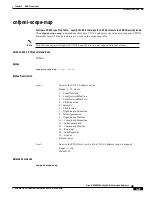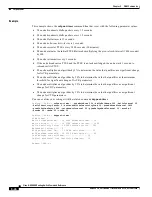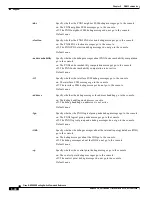
5-34
Cisco MGX 8850 Routing Switch Command Reference
Release 2.0, Part Number 78-10467-04 Rev C0, October 2001
Chapter 5
PNNI Commands
cnfpnni-pkttrace
Usage Guidelines
PNNI trace commands have characteristics that standard debug commands lack, namely:
•
Trace commands debug interactions between different software modules or within a module.
•
Trace output goes to a system trace buffer, not to the console.
•
Tracing controls a more granular filtering of unnecessary debug output.
Related Commands
dsppnni-pkttrace, dsppnport, dsppnports
Attributes
Example
Configure then display a trace that examines the contents of PNNI Hello packets, as follows:
•
The transmit packets are traced.
•
The packet trace occurs at node index of 1 (the default for cnfpnni-pkttrace and therefore omitted).
•
The packet trace takes place on the port identifier of 17504.
Geneva.7.PXM.a > cnfpnni-pkttrace tx 17504
PNNI/tx_packet on port 17504 at level 56
> 01:00010064 01010100 000038a0 47009181 00000000 309409f3 b8003094
> 02:09f3b801 47009181 00000000 309409f3 b8003094 09f3b801 38470091
> 03:81000000 00000000 000038a0 47009181 00000000 001a531c 2a00001a
Geneva.7.PXM.a > dsppnni-pkttrace tx -portId 17504
Node Index :1 Port id: 17504 Tx Pkt Trace on
Geneva.7.PXM.a >
-portId
The port ID in this instance has the format of the logical ID number. The format is a
32-bit encoded number in the range 1–2147483648. If you do not have the port ID in
this form, use dsppnport and provide it with the common portID format of
slot[:subslot].port[:subport}. The output of dsppnport shows the logical number for
the port ID. Use this value is for the -portID parameter.
-svcIndex
PNNI uses the SVC index as a reference to the SVC-based, logical, horizontal link.
This parameter is meaningful only if you specify node-index.
Default: none
Note
The current release does not support Routing Control Channels for
Switched Virtual Connections (SVCC-RCC), so this value must remain 0.
Log: log
State: active
Privilege: SERVICE_GP
















































